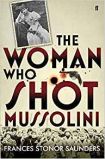The Woman Who Shot Mussolini by Frances Stonor Saunders
| The Woman Who Shot Mussolini by Frances Stonor Saunders | |
|
| |
| Category: History | |
| Reviewer: John Van der Kiste | |
| Summary: A biography of Violet Gibson, a member of the Anglo-Irish aristocracy who nearly succeeded in assassinating the Italian dictator in 1926. | |
| Buy? Yes | Borrow? Yes |
| Pages: 384 | Date: March 2010 |
| Publisher: Faber and Faber | |
| ISBN: 978-0571239771 | |
|
| |
Most British titled families of the 19th and 20th centuries have produced their fair share of rebels. Yet few came as close to changing the course of European history as the Honourable Violet Gibson, one of eight children of Baron Ashbourne, a Protestant Anglo-Irish peer and MP in Disraeli's government during the 1870s.
Violet was born in 1876. In those days, the ultimate destiny for women of her class was to marry within their ranks, or remain as spinsters, stay at home and look after their parents. For recreation they could learn languages, the social graces, and read – but not too much, as this could create an excess of independent thought.
However, she was too independently-minded for the family's own good. Serious-minded, full of sympathy for Irish nationalist aspirations, and an early supporter of the Labour party, at sixteen she became a Roman Catholic. The conversion (or 'perversion', as some would have it) estranged her from her parents, and she spent some time in what almost amounted to voluntary exile in Switzerland before returning to London, where she joined the Bohemian world and became engaged to a young artist in 1908. His name is unknown to posterity and almost nothing is known about him, beyond the fact that he died suddenly the following year.
With his death, she turned even more fervently to her faith, and settled briefly in Rome. Ill-health sent her back to England, and after being diagnosed with a rare form of cancer her left breast was removed. Further operations for appendicitis and peritonitis left her a very sick woman, but did little to distract her from her work as a peace activist. A combination of these factors, grief at the death of various members of her family (despite her differences with most of them) and her horror at the stirrings of fascism under Il Duce, Mussolini, in Italy, a country she had grown to love, led her to the deed for which she would always be remembered. On 7 April 1926 she joined the crowds waiting outside the Palazzo dei Conservatori, waiting for Mussolini to emerge. As he left the building and walked towards his car, she raised her revolver and fired. The bullet merely grazed the side of his nose, which was bandaged so he could continue with the rest of his appointments for the day.
The remaining thirty years of her life were a sadly protracted postscript. There were calls for her execution, but Italy had already abolished the death penalty, and magistrates concluded that she could not be put on trial because of 'mental infirmity'. One year later she was released without charge and deported to England, spending the rest of her life in St Andrew's Hospital for Mental Diseases in Northampton. Most of its patients were fee-paying 'chronic ladies and gentlemen', suffering from physical and 'moral' disorders including 'disappointment in love, pecuniary difficulties, religion, novel-reading and spiritualism'. (Yes, novel-reading – that's most of us beyond redemption, then). To add to the woes she also had a mental breakdown, attempted suicide, and fell out even further with her family before she became progressively enfeebled and passed away.
This book tells us not only the sad saga of her captive years, but also much about the way in which women of independent thought were viewed at the time. It also reveals much about the general view of Mussolini. Not until the invasion of Ethiopia in 1935 did Britain and Europe in general revise their opinions about the man with whom they had been so anxious to keep on good terms, and the fulsome expressions of congratulation on his escaping from the assassination attempt without serious injury seem strange in the light of subsequent events. It is not a comfortable read, but by using the 'main event' as a focal point, it reveals much about changing attitudes – towards the status of women, the aristocracy, mental health, religion and inter-war politics and diplomacy – in Britain during the age. The author has done well in covering so many fields so effectively.
Our thanks to Faber & Faber for sending a review copy to Bookbag.
If this interests you, for more on the period, why not also try We Danced All Night: A Social History of Britain Between the Wars by Martin Pugh; or for another biography of a rebellious aristocratic lady, Daisy: The Lives and Loves of the Countess of Warwick by Sushila Anand.
Please share on: ![]() Facebook,
Facebook, ![]() Twitter and
Twitter and
![]() Instagram
Instagram
![]() You can read more book reviews or buy The Woman Who Shot Mussolini by Frances Stonor Saunders at Amazon.co.uk Amazon currently charges £2.99 for standard delivery for orders under £20, over which delivery is free.
You can read more book reviews or buy The Woman Who Shot Mussolini by Frances Stonor Saunders at Amazon.co.uk Amazon currently charges £2.99 for standard delivery for orders under £20, over which delivery is free.
![]() You can read more book reviews or buy The Woman Who Shot Mussolini by Frances Stonor Saunders at Amazon.com.
You can read more book reviews or buy The Woman Who Shot Mussolini by Frances Stonor Saunders at Amazon.com.
Comments
Like to comment on this review?
Just send us an email and we'll put the best up on the site.


